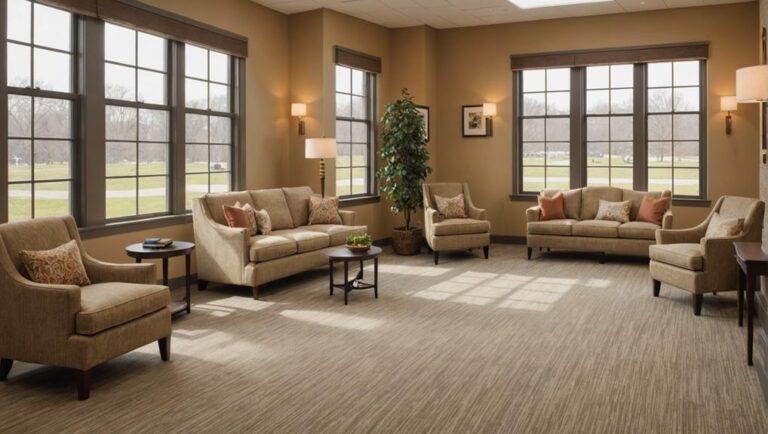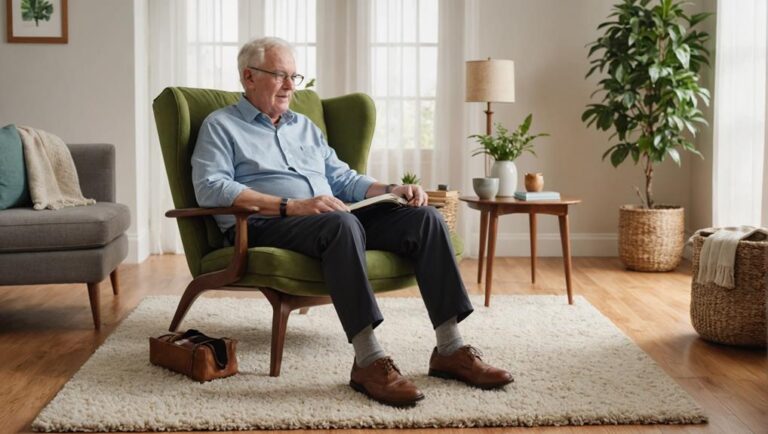When choosing safe flooring for residents with limited mobility, it's vital to prioritize slip resistance and cushioning. Opt for materials like vinyl, rubber, or low-pile carpet to enhance stability and comfort. Textured surfaces improve grip, while high-contrast colors aid visibility. Guarantee smooth changes between different flooring types to prevent trip hazards. Regular maintenance is essential to keep surfaces safe and clean, addressing any wear or damage promptly. Remember, well-planned flooring not only reduces risks but also aids mobility. There's plenty more to reflect upon to make informed choices that enhance safety and accessibility.
Importance of Safe Flooring
When it comes to creating a safe living environment for individuals with limited mobility, the importance of flooring cannot be overstated. The right flooring plays a significant role in enhancing accessibility and ensuring safety. You'll want to reflect on how flooring materials can impact movement, stability, and overall ease of navigation within a space.
Adhering to flooring regulations and accessibility standards is essential. These guidelines are designed to minimize risks and create environments that accommodate individuals with varying mobility levels. For instance, flooring should be slip-resistant, smooth, and free of abrupt changes that could lead to falls or accidents. High-contrast colors can also assist visually impaired individuals in recognizing alterations in floor levels or pathways.
Moreover, the texture of flooring can substantially affect traction and stability. A smooth surface might seem appealing but could pose a risk for wheelchairs and walkers. As a result, it's imperative to select materials that offer both comfort and security.
Incorporating the right flooring is not just about aesthetics; it embodies a commitment to ensuring safety and dignity for those with limited mobility. Keeping these factors in mind can empower you to create a living space that fosters independence and confidence. Ultimately, your choices in flooring will reflect a deeper understanding of the needs of individuals with limited mobility, promoting a more inclusive and secure living environment.
Best Flooring Materials
Choosing the best flooring materials for individuals with limited mobility involves balancing safety, durability, and comfort. It's vital to select surfaces that minimize hazards while enhancing the living environment. One popular option is vinyl flooring, which is not only easy to maintain but also offers a cushioned feel underfoot. Its resilience helps prevent slips and falls, making it a safe choice.
Another excellent option is laminate flooring. It's durable and can mimic the look of wood or tile, allowing for a range of aesthetic choices. However, verify that the laminate is thick enough to provide a stable surface. For those seeking eco-friendly options, bamboo flooring is worth considering. It's sustainable and provides a solid, slip-resistant surface ideal for individuals with mobility challenges.
Carpet can be a comfortable choice, but it's important to select low-pile varieties that won't hinder mobility devices like wheelchairs or walkers. Look for carpets with a tight weave, as they offer better stability and support.
In addition to these materials, cork flooring deserves mention for its unique advantages. It's both eco-friendly and soft underfoot, reducing the risk of injury from falls. Its natural properties also provide a level of insulation and sound absorption.
Ultimately, the best flooring materials should address safety while allowing you to express your style. By considering both functionality and design, you can create a living space that's not only safe but also aesthetically pleasing.
Non-Slip Surfaces
Non-slip surfaces are essential for creating a safe environment for individuals with limited mobility. These surfaces greatly reduce the risk of slips and falls, which can lead to serious injuries. When selecting flooring, it's vital to take into account options with textured finishes. These finishes provide additional grip, allowing you to navigate your space with confidence. A textured surface helps to prevent slipping, particularly in areas prone to moisture, such as bathrooms and kitchens.
Moreover, incorporating color contrast in your flooring can enhance visibility and spatial awareness. For instance, using a darker floor in conjunction with lighter walls can help you identify edges and shifts more easily. This visual differentiation is particularly beneficial for those with limited mobility, as it aids in movement planning and reduces the likelihood of missteps.
You might also want to look for non-slip coatings that can be added to existing surfaces. These coatings are designed to create a safer environment without the need for complete flooring replacement. It's important to confirm that any products used are specifically formulated for the type of flooring you have, as compatibility is key to effectiveness.
Cushioning and Support
When considering flooring for limited mobility, cushioning and support are essential for your comfort and safety. Proper cushioning can help absorb impact, reducing the risk of injury during falls, while supportive flooring types can enhance stability. Understanding these factors can greatly improve your daily experience and overall well-being.
Importance of Cushioning
While many might overlook the significance of cushioning in flooring, it plays a vital role in ensuring safety and comfort for individuals with limited mobility. The right cushioning materials can greatly reduce the risk of slips and falls, which is fundamental for maintaining independence and confidence. When you step onto a cushioned surface, you're not just experiencing comfort; you're also absorbing impact, which lessens stress on your joints and reduces fatigue during movement.
Cushioning benefits extend beyond mere comfort. They provide important support that helps to stabilize your footing, making shifts from sitting to standing much safer. Floors with adequate cushioning can also minimize the harshness of falls, reducing the likelihood of serious injuries. This is particularly significant for individuals prone to falls or those with fragile bones.
Incorporating cushioning in flooring choices can enhance your overall safety and quality of life. It's crucial to prioritize these cushioning materials when selecting flooring options, as they contribute directly to a safer living environment and promote greater mobility. Your well-being should always come first, and understanding the importance of cushioning can lead to more informed decisions in creating a secure home.
Types of Supportive Flooring
Choosing the right flooring goes beyond just cushioning; it also involves understanding the types of supportive flooring available that can enhance safety for individuals with limited mobility. When selecting flooring, consider options that incorporate adaptive designs and accessibility features tailored to your needs.
Vinyl flooring is a popular choice due to its resilience and ease of maintenance. It's available in various textures, which can provide additional grip, reducing the risk of slips. Additionally, rubber flooring offers excellent cushioning and slip resistance, making it suitable for high-traffic areas, while providing shock absorption to protect joints.
Carpet tiles can also be beneficial; they allow for easy replacement of damaged sections and provide a softer surface, which can be more forgiving for falls. However, guarantee the carpet has a low pile to reduce trip hazards.
Lastly, consider using interlocking foam tiles, especially in living areas. These provide a soft surface that's easy to walk on and can help with stability. By choosing the right supportive flooring, you can create an environment that promotes safety and enhances mobility, allowing for greater independence in daily activities.
Installation Considerations
Installing safe flooring for individuals with limited mobility requires careful planning and consideration of various factors. You'll want to guarantee that the flooring not only meets safety standards but also incorporates essential accessibility features that facilitate movement. Start by evaluating the specific needs of the individual, as certain limitations may require particular installation techniques. For example, if wheelchair accessibility is a concern, flooring should be smooth and level to allow for easy navigation.
When selecting your flooring material, consider slip resistance and cushioning properties. These factors can greatly reduce the risk of falls, which are a common concern for those with limited mobility. During installation, confirm that changes between different flooring types are seamless and free of tripping hazards. This can involve using transition strips or leveling the edges of flooring materials.
It's also important to keep in mind the layout of the space. Wider pathways should be created to accommodate mobility aids like walkers or wheelchairs. If you're working with professional installers, communicate your specific needs and preferences clearly, so they can implement the most effective installation techniques tailored to your situation.
Maintenance and Care Tips
Maintaining safe flooring for individuals with limited mobility is vital to guarantee continued accessibility and prevent accidents. Regular maintenance not only preserves the aesthetic of your flooring but also assures its durability and safety. Here are some practical tips to help you care for your flooring effectively.
Start with appropriate cleaning techniques that match your flooring type. For hard surfaces, a damp mop with a mild cleaner can remove dirt without leaving slippery residue. Avoid harsh chemicals that might degrade the flooring material over time. For carpets, regular vacuuming is essential. Consider using a vacuum with good suction and a beater brush to pick up debris effectively, while also making sure it's lightweight and easy to maneuver.
Inspect your flooring regularly for signs of wear or damage. Look for loose tiles, cracks, or fraying edges. Address these issues promptly to prevent tripping hazards. If your flooring is made of wood or laminate, consider applying a protective sealant to enhance durability and resist moisture damage.
In high-traffic areas, consider using area rugs with non-slip backing to provide extra grip and comfort. Make sure that they're securely placed to avoid shifting or curling, as this can pose a risk for falls.
Frequently Asked Questions
What Flooring Options Are Best for Outdoor Spaces?
When choosing flooring for outdoor spaces, you'll want to prioritize slip-resistant materials that guarantee safety. Options like textured concrete, rubber pavers, or treated wood provide excellent outdoor durability while minimizing the risk of slips and falls. These materials can withstand various weather conditions, maintaining their integrity over time. It's crucial to reflect on both aesthetics and safety, guaranteeing your outdoor area remains both functional and inviting without compromising on security.
How Do I Choose Colors for Safety and Visibility?
When choosing colors for safety and visibility, you'll want to focus on color contrast and light reflection. High contrast between the floor and surrounding elements helps individuals identify edges and obstacles more easily. Light-colored surfaces can enhance visibility, especially in low-light conditions, while darker colors may absorb light, reducing visibility. Consider using bright, reflective colors to create a safer environment, ensuring that pathways and changes are easily distinguishable for everyone.
Are There Flooring Solutions for Pets and Limited Mobility?
Imagine a cozy home where your furry friend can roam freely, yet safety remains a priority. For your space, consider pet-friendly materials like vinyl or laminate, which offer durability and easy cleaning. Slip-resistant surfaces are essential, reducing the risk of falls for both pets and residents. By choosing flooring that balances comfort and safety, you're creating an environment where everyone, including your pets, can thrive without worry.
How Do I Assess My Flooring's Current Safety?
To assess your flooring's current safety, start by checking its slip resistance. You can do this by evaluating the surface texture and conducting a simple water test. Next, consider the floor maintenance; regular cleaning and addressing wear and tear are essential for preventing slips. Additionally, examine changes between different flooring types, as these can pose hazards. By taking these steps, you'll create a safer environment for everyone in your space.
Can I Use Area Rugs Safely With Mobility Aids?
Yes, you can use area rugs safely with mobility aids if you consider rug types and placement. Choose low-pile, non-slip rugs to minimize tripping hazards. Make certain rugs are securely anchored, either with rug pads or double-sided tape, to prevent movement. Place rugs away from high-traffic areas or changes between surfaces. Regularly check for wear and tear, as maintaining a safe environment is essential for your wellbeing and mobility.




